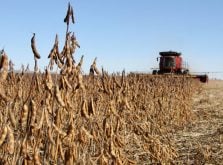BELLE PLAINE, Sask. – Federal agriculture minister Gerry Ritz trotted out the “win, win” cliché during the grand opening ceremony for Terra Grain Fuels, a $145 million wheat ethanol facility located in southern Saskatchewan.
“It’s a win for farmers who now have a new market for 15 million bushels of wheat right here in their backyard. And it’s a win for livestock producers. The dried distillers grain (DDG) will give them a new economical source of feed,” the minister told producers, dignitaries and members of the media packed into a piping hot tent.
Read Also

Manitoba extends Crown land rent freeze
Manitoba government links the continued rental rate freeze on grazing and forage leases to economic and environmental challenges facing the industry
The last part of the minister’s statement might be a stretch, according to local livestock producers.
Russel Kirzinger of the Buffalo Plains Cattle Co., a 3,500 head feedlot in Balgonie, Sask., that also has 3,500 head on grass, has sampled the distillers grain from Terra and was impressed.
“I like feeding it. I like using the product.”
The only problem is he can’t afford it.
“They’re asking for barley prices,” Kirzinger said. “From our standpoint, we don’t feel it is that valuable.”
It doesn’t make economic sense for Buffalo Plains to incorporate Terra’s dried distillers grain into its rations at those prices.
“The numbers just don’t work out. Good for them that they found markets where people will pay more.”
Terra Grain Fuels president Tim LaFrance said the plant will produce 165,000 tonnes of DDG annually once it is running at full capacity. Most of that will move by rail to the coast where it will be shipped to markets in Europe and Asia.
The company can charge barley prices for its product because it is being marketed as a high value, genetically modified-free protein replacement in dairy and aquaculture diets.
“Even with the transportation, it still is attractive for us to do that. It produces a superior return,” LaFrance said.
Bill Jameson, president of the Saskatchewan Cattle Feeders Association, said even if the price was right, only a small portion of the ethanol byproduct would be consumed by local feedlots.
There are about 20,000 head of cattle on feed in the area surrounding the Belle Plaine plant.
“It would probably have to increase 10-fold in order to take all the product. That’s certainly not going to happen in the near term,” he said.
Part of the rationalization for provincial and federal ethanol mandates is that ethanol plants would attract additional livestock investment.
“There will be distillers grain coming out of here to feed our feedlots,” Ritz said during a media scrum at Terra’s grand opening.
“We need those in Saskatchewan. Right now most of our calves go west to Alberta.”
Jameson said feedlot expansion hasn’t happened yet, most likely because the economic climate for livestock investment isn’t enticing at the moment. However, he hopes the Belle Plaine facility will eventually be a magnet for investment.
“We’re very pleased that Terra has built this plant and we’re hoping to tag along with them and increase the livestock sector.”
Kirzinger doesn’t think Terra’s overseas markets will be there forever, given ever-increasing transportation costs. If the market contracts and the price of the company’s DDG falls, local livestock producers will have a distinct freight advantage.
“There will be a day down the road where it will be a fit for the beef industry,” he said.
For the time being, however, the company doesn’t foresee changing its aggressive overseas sales strategy.
“We’re going to continue down that path because that’s the natural marketplace for this,” LaFrance said.















